Table of Contents
ToggleA Study Of Omni-Channel Business Models In The Chinese Fashion Industry
Acknowledgement
I want to thank my assessor who helped me in every stages and guided me systematically. Also I am very much pleased with the behaviour of the respondents. While performing this research I learned various aspects of the research and also my presentation and communication skills has been improved. I want to thank my parents who always supported me and provide courage. I hope this detail analysis will help the reader to explore the Omni channel business model in the Chinese fashion industry.
Abstract:
Omni channel is the process of allowing consumers to buy product by using various channels. His is the high rated marketing strategy to increase the sales and also developed the consumer loyalty. Zara and Uniqlo both are branded company and have huge consumer base in the Chinese fashion industry. Both the company are using the Omni channel business model to increase their sales and this study highlighted the various aspects of using Omni channel business model by these two fashion giants in china. Zara is mush sophisticated regarding their product and always follows the current trends in the industry where as Uniqlo focuses on the quality of the products and simple style. Main aim of this research is to explore the importance and value of using the Omni channel business model in these two fashion giants.
For conducting the research, researcher followed various methods as required. Positivism philosophy and deductive approaches has been taken to conduct the research properly. Primary research has been conducted with quantitative analysis. 30 respondents who are the consumers of these two companies has been selected and survey conducted with them.
Form the analysis it is very much clear that most the respondents are purchasing their products through online. Also analysis revealed that there are various factors that influences the consumer buying decision while purchasing online like discount, product review, quality, price and few others. Also the research revealed that consumers are much satisfied with the products of these two companies and also comfortable in handling the e-commerce platform. Still there are some contradiction regarding the product design of these two companies as some respondents supported the Zara while other with Uniqlo.
Still some areas are there which are needed to be improved effectively by following few development. Increasing resources and proper management of the resources will help the companies to sustain their business in more convincing way. Whereas developing the workers for managing the business and productivity is also be helpful for the companies.
Table of Contents
Chapter 1: Introduction. 7
1.1 Introduction. 7
1.2 Research background. 7
1.3 Research aims and objectives. 8
1.4 Research question. 8
1.5 Rationale of the study. 8
1.6 Significance of the research. 9
1.7 Structure of the study. 9
Chapter 2: Literature review.. 10
2.1 Introduction. 10
2.2 Critical evaluation based on different players of online and offline business in China. 10
2.3 Critical discussion on the factors having prominent impacts on customers’ perceptions regarding brand value. 12
2.4 Impacts of inbound and outbound logistics on value chain. 14
2.5 Critical analysis based on different theories and models for managing online and offline business activities 16
2.6 Critical evaluation based on impacts of differential buying behavior of customers on marketing process 16
2.7 Critical analysis based on impacts of customers’ anthropological features on retail marketing in China 18
2.8 Understanding based on the ways which impact on business growth in China. 19
2.9 Comparison and contrasting between strengths and weaknesses of businesses in Chinese fashion markets 21
2.10 Gap in literature. 22
2.11 Conceptual Framework. 24
2.12 Summary. 25
Chapter 3: Research methodology. 26
3.1 Research Philosophy. 26
3.2 Research Approach. 26
3.3 Research Design. 26
3.4 Data collection. 27
3.5 Data analysis. 27
3.6 Data sampling. 28
3.7 Ethical Consideration. 28
3.8 Limitation. 29
Chapter 4: Data analysis. 30
Chapter 5: Discussion. 48
Chapter 6- Recommendation and conclusion. 50
6.1 Conclusion. 50
6.2 Linking with objectives. 50
6.3 Recommendation. 51
6.4 Future Scopes. 51
6.5 Limitations. 52
References. 53
Appendix: 57
Chapter 1: Introduction
1.1 Introduction
The core of the Omni channel or Omni-business model is defined as the multiple channel strategy of marketing (Wiener et al. 2018). This also helps in the facilitation of the integrated services to the customers. This can help the customer to make efficient shopping through the modes of online experiences. The devices like the mobile, computer and other electronic assistances are building block of the Omni-business model. This also helps the customer to derive the benefits from various sales channels to make their receiving process and buying a process more robust and successful. This also helps in the innovation of the integration of touch seamless services.
Omnichannel business is a business model that operates in various online as well as offline channels such as online shopping platforms, smartphone applications and physical stores (Koc and Bozdag, 2017). The Omnichannel approach helps the company to sell its products through various kinds of channels giving the customers seamless and comfortable shopping experience. In this way, customers get multiple types of options for shopping. With the prevalence of numerous digital media, it has become almost necessary for brands to adopt the Omnichannel approach in their business operation for staying ahead in the highly competitive market. With the help of the Omnichannel approach in the business operation, the business organisations can promote their brand image and create a positive customer perception about the brand. The following report discusses the Omnichannel business model of fashion brands Zara and Uniqlo in the Chinese fashion industry.
1.2 Research background
The Chinese fashion industry is a highly competitive industry having numerous high fashion brands operating their business in it (Bonetti, Perry and Fernie, 2017). Two such highly popular brands operating their business in the Chinese fashion industry are Zara and Uniqlo. These two brands have been strong competitors from the very first time they entered the Chinese fashion industry. Both of these brands run a successful business in the Chinese fashion industry today. There are certain differences between these brands. While Zara is a Spanish origin fashion line, Uniqlo is a Japanese fashion brand. Zara is a Spanish appeal retail industry and it is globally reputed in the marketing of the fashion industry. The company is founded by Amancio Ortega in the year 1975(Zara, 2020). The company has active stores which are nearly 2,250. The annual revenue of the company is nearly 18.021 million Euros. Uniqlo is the fashion retail company based on the wholly-owned subsidiary. The company was founded by Tadashi Yanai in 1949. The main products of this company are clothing(Uniqlo, 2020). The company has nearly 44,400 active employees. The headquarter of the company is located in Tokyo located in Japan.
The design of the products and the structure of the value chain of these brands are quite different from each other. Zara mainly focuses on high-frequency fashion updates and new trends in their product design. Whereas Uniqlo’s main interest is to design and offer a simple and comfortable fashion wear to their customers. The business operation of these brands also differs in the way their supply chain work and the marketing strategies of these brands also are quite different from each other. However, in the rapidly growing digital age, both of the brands Omnichannel business model. There are different online as well as offline mediums that are used by these companies to operate their overall business functions and for selling the products in the Chinese fashion market. Therefore the implementation of the Omnichannel business model is much different for these two brands. Both of the brands use their unique strategies of utilising the Omnichannel approach in their business operations to gain competitive advantages in the Chinese fashion industry.
1.3 Research aims and objectives
The main aim of the study is to evaluate the significance of omnichannel business models in the Chinese fashion industry by comparing ZARA and UNIQLO cases. The objectives of the research are:
- To thoroughly analyse the customer behaviour of the target market segments of these brands.
- To assess the anthropological features of the customers such as their fashion values, preferences, choice of website characteristics, store layout and so on.
- To assess the opportunities for Zara and Uniqlo to grow their business in the Chinese fashion industry.
- To identify the market strengths and weaknesses of the Chinese fashion market in order to analyse future opportunities and threats for Zara and Uniqlo in the Chinese fashion industry.
1.4 Research question[A1]
1.5 Rationale of the study
Identification of research rationale is based on finding key issues as well as its impacts on the current business market. It has been observed that a number of Chinese fashion retailers are facing issues in current business as most of them are engaged in managing their business through physical stores (Oliver Wyman, 2020). This has become one of the prominent issues in current business markets in China.
This is an issue because integration of both online and offline retailing is promoting business process of Chinese fashion industry in a genuine way. Therefore, the companies which are not properly focused to attain Omni-channel marketing are facing critical issues for maintaining business in a continuing manner. As per the thoughts of Yrjölä et al., (2018), in a country all of the targeted customers can never be satisfied with basic types of marketing methods. In such competitive environment, Zara and Uniqlo are trying to bring positive changes in their business process for being stable in competitive market in Chinese fashion industry.
This study is conducted on the Chinese fashion industry to understand the opportunities and threats it can project on the business operation of the fashion brands, Zara and Uniqlo. The Omnichannel approach of these two brands is compared with each other for assessing their success levels in the Chinese fashion market. The research study will evaluate the effectiveness of the strategies used by Uniqlo and Zara in the Chinese fashion market for comparing the different business goals that provide them with the unique individual brand image and help them gain competitive advantages against each other in the Chinese fashion industry.
1.6 Significance of the research
The omnichannel business model is a necessity of the business organisations in the rapidly growing fashion industry of China. With the assessment of the opportunities that the Chinese fashion industry offers to foreign fashion brands like Zara and Uniqlo, the future business growth of these brands in the industry can be predicted providing an effective guideline for the fashion brands. The analysis of the customer behaviour of the target market segments of Zara and Uniqlo, it will be possible to assess an understanding of the customer preferences and requirements in the Chinese fashion market which will provide a proper guideline for developing suitable marketing strategies for these two brands. This also helps to make the proper clarifications on the case studies of the given two companies to make them better profitable for the Chinese fashion industry. This will also help the two companies from two different nations to recognise the trends and demands of the citizens of China. This will also help the Chinese fashion industry to make various collaborations and links to create a web for the development of the exclusive fashion realm in the world. This will also help the fashion industry of China to make better innovations in the fashion realm to make the customer feel modernised and sophisticated.
1.7 Structure of the study[A2]
In this report, the general structure of the research project writing is followed. At first, the introduction to the topic of the research project is provided with a detailed description of the research objectives and background of the research topic. The introduction section provides a proper understanding of the rationale of the study and the significance of the research. After that a detailed discussion on the respective subject of Omnichannel business model with reference to various literature. After that, the methodology section of the study is provided describing the methods and techniques used to conduct the entire study. Then the survey results of the project are provided followed by the discussion of the findings of the survey. After that suitable recommendation are provided for improving the business performance of Zara and Uniqlo in the Chinese fashion industry with the use of Omnichannel business model. At last, the overall conclusion of the study is provided.
Chapter 2: Literature review
2.1 Introduction
The designing of the literature review is the searching process which helps in the evaluation of a given topic or subject. The literature review describes the artistic way by which the researcher draws the climax of its research. The researcher also represents some throes and concepts in the literature review. This also helps in the conceptualization of the knowledge on the selected topic. According to Yarahmadi and Hasheminejad, (2020) this refers to the initiation of the scholarly work which research performs to state its analysis and concepts. The researcher also finds its inconstancies and gaps of previous research of the selected subject through the designing of the literature review.The chapter is critically based on highlighting the reviewing as well as analysis of various literary sources which are focused on different strategies and approaches for conducting business through both online and offline medium. The omnichannel business model is helpful for the fashion industry to expand its service process along with impacting on customers’ perceptions in a positive manner. In this respect, this chapter has involved critical discussion by considering a case study of Zara and Uniqlo. The efficiency of business organisations is directly linked with changing customers’ perceptions in a positive or negative manner. Hence, it can be mentioned that analysis of the proper business environment and basic customers’ demands regarding both online and offline business processes become helpful in this respect to analyse the scenario in depth.
2.2 Critical evaluation based on different players of online and offline business in China
It is an obvious fact that expanding business through both online and offline mediums are helpful for an organisation to support the growth and stability of business in a prominent manner. As mentioned by Wiener et al., (2018), customers’ demands fulfilment is the sole controller of the omnichannel business process. In this respect, the players for online business processes are the media and numbers of people who use the internet and e-commercing sites for shopping. According to Bonetti, Perry and Fernie (2017), the trends of the fashion industry in China has changed in recent years and shifted towards more online and digital platforms for sales and marketing. This shows that the inclination of the consumers of the country has been towards the online stores due to the convenience of delivery and choice without limitation on time for shopping. This convenience cropped with discounts and offers have also shaped the changes noted in the consumers of the fashion industry in the country. The advancement of technology and the internet becoming popular in the country is yet another reason for the changes in the consumption medium in the country. For example, the report published by Statista (2020), highlights that in China there are about 65% of people who are adjustable to use the internet. Thus, it can be a prominent scope for companies such as Zara to maintain their online business in China for a longer period of time. In addition to this, the market research conducted by Marketing China (2020) makes the fact clear that about 35% of the retail market in China is under the control of e-commercing. A number of business entrepreneurs are focused to capture about half of the global market through online business processes.
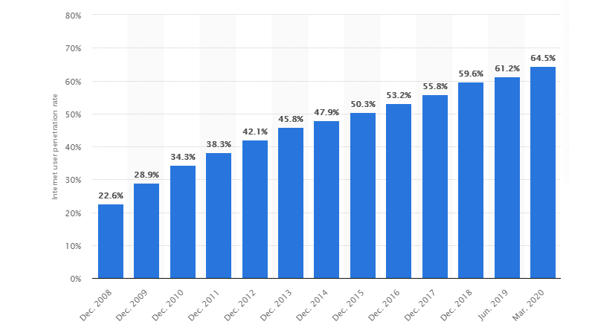
Figure 2.1: Development of an online business process in China
(Source: Statista, 2020)
Strong media presence acts as an influencer for developing the effectiveness of the online business procedure. On contrary to this, Nisar and Prabhakar (2017) argued that digital ways of selling functions reduce the need to hire immense numbers of employees whereas the offline business process is totally dependent on involvements of efficient employees. In this regard, employees can be considered as the key player to maintain consistency in the online and offline business procedure. As opined by Wiener et al., (2018), maintenance of online as well as offline business needs to incorporate renowned stakeholders. This player is constantly stable in the fashion market in China. In this respect, it has been observed that Zara is equally focused to maintain through both online and offline medium whereas Uniqlo is only focused to manage their business through the offline medium. It can be mentioned that maintenance of both offline and offline selling process helps a company to attain huge market expansion by overcoming severe industry issues of the market. The limitation of the offline stores such as time required for shopping as well as the timing of the opening of the stores is a barrier to the sales of the company. The offline stores also require extensive financial and human resources that need to be allocated for the maintenance of the offline stores. The online stores, however, require lesser involvement of HR and automation is also proving to be an efficient means of order fulfilling. The lesser number of employees involved as well as the process of direct to consumers of the products of the company means that discounts and offers can be given to incentivize the purchase behaviour of the consumers in the country. In this respect, it can be identified that the current fashion industry in China is facing the below-mentioned issues-
Recently, the coronavirus outbreak has impacted on the business process of the fashion industry in China in a negative manner. As per the words of Barrie (2020), quarantined workers, material delay as well as travel restrictions have created barriers for the fashion industry to remain on track. In this respect, it can be highlighted that online delivery business of clothing can have success in such a market as it is able to support customers’ perceptions with making contactless delivery. Thus, it is one of the prominent facts that considering customers’ interests can help a business industry to be stable in a competitive market.
Noto La Diega(2019) stated that labour issues in the Chinese fashion industry are one of the major reasons for the problems. The legal implications of the country are whipping to control any labour issues such as low wages, minor labourers and unhealthy workplace to name a few of the problems. These along with the disrupted supply chain for the employee welfare of the industry mean that the fashion industry should change their approach to mend the issues. The limitation of the virus outbreak has also pointed out the weaknesses of the production line of the fashion industry of the country.
The new innovation of the Chinese market is named as the New Retail revolution of China. This has been developed in the year 2019. This innovation is to improvise the offline and online systems used in the markets of China. Jack Ma of Alibaba has called this innovation as the “Boundaryless Retail”. According to Davis (2020), the practices of the New Retail revolution of China are based on many features and factors. The fourth one is the installation of the Hema applications to ship in-store. This application will give the customers to have personalized services and products. The second feature is to use the Payment in-store by mobile wallet. This will accelerate the transaction facilitation of the customers. The third one is the app-frost New Retail model to accelerate the customer online. There are also many features in this innovation like the multichannel shopper which are almost double as valuable and 7Fresh which improves the equality of the different products. This new system will make the qualities and deliveries of the fashion article of Zara and Uniqlo more branded and sophisticated. This will increase the experiential level of the retail business in China through online mode. The technological assistance is also provided to make the shopping system more modern and attractive.
2.3 Critical discussion on the factors having prominent impacts on customers’ perceptions regarding brand value
Customers’ perceptions play a major role in managing the brand value of specific products or business processes. As stated by Iglesias et al., (2017), it is an evident fact that until or unless a company becomes able to satisfy its customers’, it can never be able to uplift its brand value in existing and targeted markets. In this regard, positive brand value denotes that customers’ prefer the concerned business over more over their competitors. On the other hand, the negative brand value in market denotes that the competitor’s companies are using more efficient business strategies to reach a huge market portion. In support of this statement, Tajvidiet al., (2017) stated that in most of the cases business organisations become focused on their product development as a result of which customers’ intentions are affected. Then it leads to reduce the business image in existing as well as in targeted markets. From the website information of Zara (2020) shows that last year this company has expanded their market range in china based on prominent development of Supply chain through both Omnichannel system as well as bringing products innovation for meeting customers’ requirements.
Apart from this, it has been observed that the brand value of Uniqlo, 2020 is developing in China based on the establishment of physical stores. It is an obvious fact that most of the business organisations are focused to attain maximum numbers of potential customers through the easiest way. Conducting online business can be helpful for a business organisation to reduce the expense of a manual operational process which in turn can be effective to impact on the development of customers’ values to their business process. In the views of Simon and Tossan (2018), co-creation of brand value and maintenance of market stability is based on how smoothly customers take the presence of business in the market. On the other hand, Iglesias et al., (2017) argued that maximum numbers of loyal customers in target market denotes appropriate development of brand value in the market.
It can be assumed that the development of Omnichannel business process by attracting maximum numbers of potential customers is critically helpful to foster growth and development of the business industry. Similarly, the growth and development of the fashion industry in china can be benefitted by introducing Omnichannel marketing process. One hand, it is effective to maintain continuity in e-coercing process, on the other hand, it will be beneficial to attract huge numbers of customers. As a result of this, customers’ perception is affected in a positive manner which ultimately adds fuel to the growth and development of market range and business base in the industry.
Cook and Yurchisin(2017) opined that the consumers are very sensitive to pricing of the fashion goods in the country. Hence, it is important for the retailers to conduct extensive market and competitor analysis in order to competitively price the products that can entice the consumers whilst also generating profits for the companies. It should also be mentioned that the use of the proper pricing strategy is also required for the provisions of the discounts and offers. This has also been corroborated by Kalla et al., (2017) who said that the fashion industry, especially the fast fashion and the retail chains of the world should intelligently price their products and quality to assure the consumers that they are getting their money’s worth. This is critical to convince them into buying.
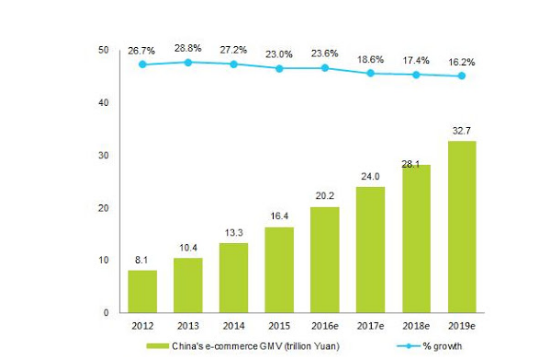
Figure 2.2: Development of e-commercing in the fashion industry in China
(Source: Williams, 2020)
2.4 Impacts of inbound and outbound logistics on value chain
Both processes of the inbound and outbound logistics are significant for the gross management of the supply process. The logistics based on the inbound is based on the allocation and buying of the materials and substances and special guidance and care are taken for their maintenance. This also helps in the formation of the links with the external companies. The input process and management are included in inbound logistic management. The outbound logistics refers to the professionals and their roles in the movement of the materials and substances from one terminus to the other terminus. This also helps to maintain the balance in the business dynamics of the company. The customer relationship and supplier relationship management are also considered in outbound logistics.
Inbound and outbound logistics have prominent impacts on maintenance of value chain activities. As per the views of Nagy et al., (2018), most of the business companies are focused to maintain a link between their inbound and outbound functions which can be beneficial for them to maintain organisational efficiency at a steady manner. Maintenance of organisational efficiency is helpful for grabbing most efficient customers from the targeted market. In support of this statement, Koc and Bozdag (2017) mentioned that maintaining links between inbound and outbound activities help to flourish business through Omnichannel processing. The inbound logistics should also be able to support the outbound logistics and a balance has to be created for the efficiency of the business operation. The management of the company should maintain the HR and the functions of the company so that the delivery of the goods to the consumers can be timely and of the expected quality.
Main inbound business activities are based on the development of infrastructure with the help of internal business process efficiency. Along with this, maintenance of workforce, training and development programme, as well as maintenance honesty in financial transactional activities, are some of the critical inbound business activities. Hence, it can be mentioned that the maintenance of the service process through inbound activities are the sources to establish a healthy offline business. On contrary to this, Wiener et al., (2018) commented that outbound business activities are helpful to flourish the business process through online servicing process. In this respect, technical management, supply chain maintenance and development of a business relationship with business partners can be considered under business outbound activities. Often it has been observed that different companies which are involved in managing their business through e-commencing process try to develop their outbound activities. For example, Zara is such a fashion retailer in China that is more focused to their outbound functioning rather than their inbound activities which have made them able to maintain service process consistency in a number of locations in China.
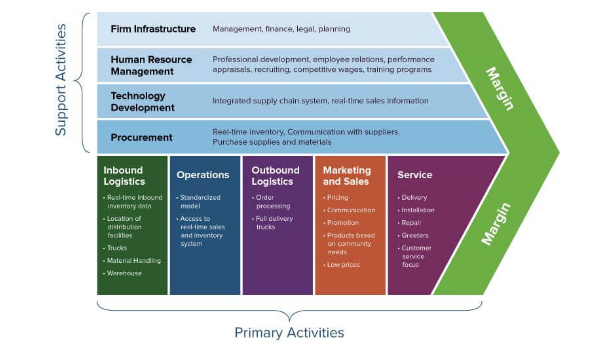
Figure 2.3: Relationship between a value chain and business logistics
(Source: Jaradatet al., 2017, p. 50)
In order to develop a business process based on Omnichannel retailing in the fashion industry, inbound and outbound activities are essential to be maintained in an effective way. In this respect, it can be highlighted that the business process which is based on offline marketing must consider the development of their inbound activities and the businesses based on Omnichannel marketing must consider both inbound and outbound logistics activities. In the views of Jaradatet al., (2017), the customer base of fashion industry develops based on attracting genX and millennial, so that businesses under this industry can be benefitted by adopting both inbound and outbound logistics into their business process.
2.5 Critical analysis based on different theories and models for managing online and offline business activities
Considering different theories and models of business can be helpful to highlight the impacts of adopted marketing system on business process off the concerned organisation. As described by Taherdoost (2018), the decision-making model of business development takes the fact into consideration that the business authority needs to focus on their customers’ perceptions to design the marketing process.The extended business strategies are based on the marketing mix approach of the 7P’s. This is the combination of the seven factors which can help to achieve the targets efficiently and easily. These seven factors are the products, price, promotion, people, process and physical evidence[A3] . In accordance with this, considering the 7Ps of the marketing mix is helpful to have an idea regarding which strategies can be helpful for the business organization to maintain marketing stability in a cost-effective manner. Koc and Bozdag (2017) mentioned that business culture is essential to attract adequate numbers of customers through the existing process of marketing. The four components of the Handy’s culture model are the Power culture, Role culture, Task culture and Person culture. This help to manipulate the dynamics of the business process of a company. This help to form the network which can be used in the creation of the strong administration of the company. The potentials of the employees, customers and other members of the company are also verified through this model. In this regard, Handy’s model of business culture discusses the fact that maintenance of internal business stability is essential for a business organization to support growth in a consistent way. On contrary to this, the value chain model is another business model which includes thee aspects of maintaining internal and external business functions to establish a stable marketing base.
An omnichannel business process is an essential marketing process in the modern business world. Thus, it can be stated that maintenance of the workforce and the creation of linking between various business activities are helpful to foster marketing process through this method. Apart from this, considering Network theory can be taken into consideration that makes the importance of linking business functions prominent. In the thoughts of Simon and Tossan (2018), any kind of business industry needs to select effective customers’ groups for development, so that Omnichannel business process can be helpful for them to foster business growth in the long run. Considering all of these aspects, it can be stated that different theories and models of business can be effective to highlight the impacts of Omnichannel business on the fashion industry.
2.6 Critical evaluation based on impacts of differential buying behavior of customers on marketing process
Customers’ buying behavior has direct impacts on development of brand image of a company in targeted market range. As described by Kanten and Darma (2017), the motto of business organizations throughout the globe is to motivate consumers and implement appropriate marketing strategies which can be prominently helpful for the buyers. As a result of this, it becomes helpful to meet marketing objectives in a competitive industry easily. On the other hand, Sobol et al., (2018) has mentioned that not only customers’ buying behaviors impact on business processes, but also the efficiency of business processes reflects on consumers’ buying intentions. In support of this statement, it has been highlighted that each and every business organization needs to assess demands and basic requirements of their targeted customers. Then only the rate of satisfaction is developed and the organizations get a chance to flourish the business process without any critical market barriers. For example, a number of renowned brands in China such as Zara and Uniqlo are directly involved in managing key customers’ demands and as a result of this healthy business competition becomes helpful for market expansion. In the thoughts of Pawłowski and Pastuszak (2017), different business industries or different marketing sectors within an industry include different types of consumers with varieties of buying behaviors. The main types of consumers’ buying behaviors can be divided into the following groups such as routine response, limited decision making, extensive decision making and impulsive buying. The following part discusses about these types of customers’ buying behaviors in-depth[A4] .
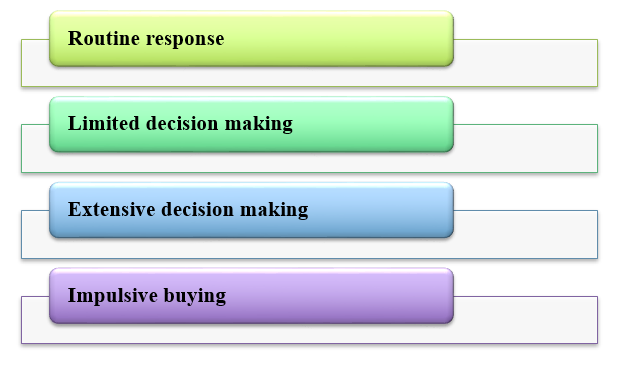
Figure 2.4: Different types of customers’ buying behaviors
(Source: Developed by author)
The routine response is based on random choosing of necessary goods from physical stores. It has been observed that a number of business organizations in China are involved in managing their business through physical stores; hence the presence of random buying behaviour is prominent among the targeted consumers. As stated by Rahman et al., (2018), when consumers are focused on their economic stability and product longevity for buying, then it can be considered as limited or extensive decision making. It has been noticed that in China, consumers’ buying intentions are changing through the past three decades. In order to support this scenario with evidence Nelson (2014) stated that development of wealth and frequent generation of new shopping trends in market are affecting consumers’ buying habits starting from youths and ending to retired persons in a differential manner. Consumer groups are differentiated in China into different subgroups such as frugal, wealthy, thirties, twenties, new generation and lastly the rich. Obviously, it becomes prominent that different customer groups must have different types of buying tastes. Fashion garments and clothing are two most wanted retail products in China. Thereby, it can be properly mentioned that buying habits must vary based on age groups and personal choices of consumers in the retail market segment. For example, Zara and Uniqlo can be benefitted by targeting young generation customers in targeted market range. As mentioned by Syaekhoni et al., (2017), changing retail trends in current market are helpful to satisfy young customers in a genuine manner. Thus, it can be assumed that analysis of customers’ buying habits and key behaviours help Chinese retail organisations to express their brand image and products’ value in targeted market range.
2.7 Critical analysis based on impacts of customers’ anthropological features on retail marketing in China
In order to analyze the anthropological factors of targeted customers, different business organizations focus on their fashion values, preferences along with mode of choice of website characteristics and healthiest way of store layout and many more. In the words of Alalwan (2018), customers’ satisfaction can never be achieved until or unless business authorities remain engaged in providing sustainable customer services. It has been found that in China, products can be sold through supermarkets, shopping malls, convenience stores, online stores and so on. In this respect, business companies need to analyze whether their customers from targeted market range can be benefitted by their marketing process or not. For example, in the busy schedule, young customers of Zara may not be able to visit physical stores and buy their necessary. In such situation it is important to manage Omni channel business model which is focused to implement both of the online and offline marketing process. On the contrary to this statement, Kanten and Darma (2017) argued that not only the marketing system is responsible for attracting good numbers of customers, but also the fashion sense and preferences of customers play crucial roles in managing appropriate growth of business along with attaining competitive advantages in a prominent manner. It is an obvious fact that buying intentions of consumers’ are regulated by economic stability, social influence as well as consistent market image of concerned company. The report published by Simpson (2019) mentions that retail innovation and targeting millennial money spenders are the prominent and current trends in retail sector in china. Hence, it can be mentioned that Omni-channel business model will be strongly helpful for different business organizations such as Zara and Uniqlo to grab plenty of competitive advantages.
In order to analyze customers’ anthropological features in current retail markets in China, it can be mentioned that the businesses which become able to adopt technological innovation in business structure, more prone to satisfy customers. Supporting this statement, Kumar et al., (2019) described that Omni channel business is totally based on the process through which business models can be developed technologically. In China, most of the retail customers are from millennial group. Thus, it becomes prominent that they must try to have buying facilities in terms of utilizing technological improvements of business structure. Thus, it can be mentioned that determinations of customers’ buying behaviors along with different types of anthropological features can be effective for retail organizations in China to gain competitive advantages in a prominent manner. Apart from this, it can be included that attractive presentation of websites and in-store decorations are another two factors that strongly control customers’ purchasing power. As explained by Agolla et al., (2018), adoption of developed technology in business process is required customer friendly services. For example, Omni-channel business model can be effective to maintain face to face discussion with customers as well as solving their issues through online service process. In this respect, different business companies such as retail companies become able to maintain marketing sustainability by fulfilling customers’ requirements in a prominent manner.
2.8 Understanding based on the ways which impact on business growth in China
Development and growth of business in Chinese fashion industry is critically dependent on the process based on management of developed service in a cost effective manner. As per the thoughts of Saebi et al., (2017), external business environments impact greatly on smoothness of business process management in a country. In this respect, stable political environment along with republic ruling system can be a critical opportunity for business organizations that maintain their business in targeted markets in China. In addition to this, China is one of the stable economic countries that provide effective economic support to different business organizations. As per the report published by Tradingeconomics (2020), it has been observed that growth rate of GDP in China is beneficial for business companies to increase their amount of annual revenue.
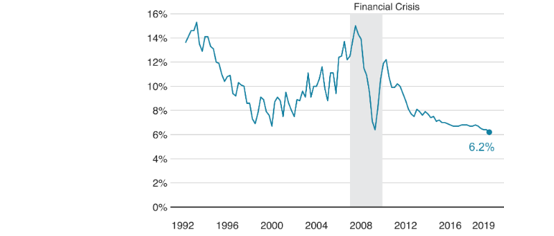
Figure 2.5: GDP rate in China
(Source: Tradingeconomics, 2020)
It is an evident fact that until or unless a business process targets effective customer base, improvement can never be possible. Therefore, the social environment of China becomes helpful for business companies as there largest population and huge types of multicultural population are present. In this regard, it has been analyzed that in China the rate of employment is 65% in 2018 which may help the authorities of business organization to have efficient labor force. For example, it can be mentioned that the business companies such as Zara and Uniqlo can be able to absorb effective market opportunities in terms of developing their business model by utilizing Omni-channel retailing system. On the other hand, Eggers et al., (2017), technological environment plays an essential role for supporting business organizations to bring innovation. In this respect, the development of e-commercing in China and enhancement of innovation driven technological environment can be critically helpful for different retail companies to derive plenty of business opportunities from Omni-channel marketing process.
Business growth of the organizations depends on many factors. It can be considered from economic perspectives or social perspectives or from other perspectives. Khan and Naeem, (2018) has mentioned that innovation capabilities of the organizations depend on the sustainability of the business growth. In the fashion market of China, there is a lack of innovation capabilities. Zhang et al., (2018) stated that due to the lack of creative freedom of the designers, innovation in the apparel products is limited in China. Therefore, this lack of innovation impacts negatively on the business growth of the fashion industry in China. From the view of Kubickova, (2019), it has been observed that business policies and laws affect highly on the business growth. The fashion organizations of China have to follow specific business policies in their business operation. Laws of the fashion industry of China enable the companies to grow in their business and to sustain competitive advantage. In China, there are rules and regulations on the copyright of the products, design patents, trade mark, and business registration and in other things which helps the companies to maintain their business operations properly and helps to develop their business in China. These rules and regulations are generated to keep in mind the business growth of the fashion companies in China. Therefore, Zara and Uniqlo have followed all the business policies of China to sustain their business growth.
According to the view of Xu et al., (2018), smart adaptation of technology influences the business growth in the modern business world. Most of the fashion organizations of China follow this strategy to grow their business in the country. It has been noticed that customers prefer to shop from the online stores rather than offline stores, therefore, Chinese fashion organizations are adopting technology in their business operations. Adaptation of technology in the business operation of Zara and Uniqlo has helped these companies to grow their business in the market of China. Grayson and Hodges, (2017) mentioned that corporate social responsibility can be considered as one of the reasons for business growth of the companies. Corporate social responsibility of the companies builds the brand image and helps to attract the customers. That is why corporate social responsibility impacts on the business growth of the organizations in this way. A huge number of companies practice corporate social responsibility in China which generate large revenues by developing the economic condition of the company. For example, Zara follows specific corporate social responsibility strategy in their business which has helped the company to sustain their business growth in China. As the corporate social responsibility strategy of zara depends on the safety of the environment, the company wants to sustain their business growth in this way. Like Zara, Uniqlo also follows corporate social responsibility strategy in their business. Therefore, it can be stated that the factors of business growth depend on the adoption of technology, business policies of government, innovation capabilities, proper corporate social responsibility strategy and on others. In the business growth of the fashion industries of China, all these factors affect highly.
2.9 Comparison and contrasting between strengths and weaknesses of businesses in Chinese fashion markets
Different fashion companies in China are focused to adopt advanced technologies for improving customers’ service and mode of business process maintenance in a critical way. Healthy economy and enhancing scopes to select diversified customers are some of the genuine strengths of retail sector in China. For example, fashion companies such as Zara and Uniqlo are focused to manage growth and development of their business by increasing the chance of having opportunities from external market segments. On the other hand, degradation in economic market with increasing rate of inflation and frequent changes in customers’ interactions with buying habits are considered as the weaknesses of business in the Chinese fashion markets.
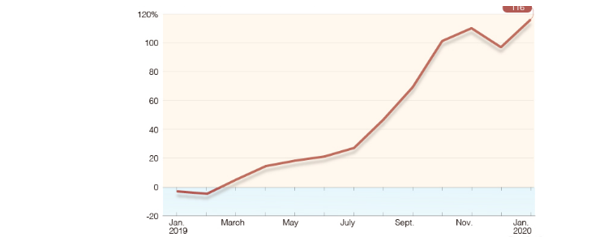
Figure 2.6: Development of inflation rate in China
(Source: Tradingeconomics, 2020)
Chinese fashion industry is one of the important segments of the economy of the country. Xu et al., (2018) stated that chineses fashion Industry has a dynamic consumer market in the country that leads the industry towards continuous development. In order to be compatible with the digital era, organizations of Chinese fashion industry are adopting technology in their business operations highly which is considered as one of the strengths of Chinese fashion industry. Chinese fashion organizations invest a large amount on the technological advancements in their business operations. For example, Zara generates a huge number of sales through their online channels. The company invests a large amount and invents new digital marketing strategies to attract the customer. On the other side, ‘Dry sketch pants’ of Uniqlo are made with technology that helps to dry perspiration of the users instantly. Apart from the adaptation of technology, the huge number of customer bases of Chineses fashion industry is one of the strengths of the industry. From the research work of Xu et al., (2018.), it has been observed that Chinese customers prefer to purchase apparel highly. Therefore, fashion organizations provide discounts, offers to their products frequently to grab the attention of the customer. As in their online and offline, both stores Zara provides huge discounts throughout the year to increase their revenue by attracting the customers. Apart from Zara, uniqlo also concentrates on the strategies to achieve the huge customer base of the fashion market of China.
Chinese fashion market is going through challenges in recent days which restrict the growth of the apparel industry. Fashion organizations fail to appeal to the customers of the new generation in the market of China which is one of the weaknesses of Chinese Fashion market. Globalization has impacted on the Chinese fission market; therefore, Chinese consumers have a wide choice of the appeal products of different styles. Influenced by globalization, from the past few years a huge number of new international fashion brands have entered into the Chinese fashion market. That is why it has been observed that domestic Chinese fashion brands fail to compete with those organizations. In the research work of Zhang et al., (2018.), it has been found that restriction on the creative freedom of the designers in China is one of the weaknesses of the business of Chinese fashion markets. Therefore, due to the lack of creativity organizations fail to attract the customers of new generations. The author also stated that in China there is a lack of a design education system; as a result, organizations lack confidence in the creative ability of the designers. This issue restricts the growth of the fashion industry in China. In order to be compatible with the changing needs of the customer, fashion organizations need to follow the recent market trends which is a lacking area of Chinese fashion market. However, as it is mentioned that Chinese Fashion market is possessed of many dynamic strength factors, issues exist equally in the industry. These issues are faced in the business of Zara and Uniqlo in China, as a result these companies are not able generate their sales properly. Proper utilization of market resources and managing customers’ demands in a right manner can be helpful for business organizations to overcome market barriers in a genuine manner.
2.10 Gap in literature
Throughout the literature review chapter, different aspects of retail marketing in China and probable customers buying intentions have been analyzed. Based on this fact, it is imperative to identify as well as highlighting the inherent gaps in previous research papers. It can be assumed that an effective research study needs to shed light on absence of interesting components as well as ineffective exploration of previous studies. In this respect, the gaps are as highlighted below-
Firstly, previous research has not includes the aspects of social media and in what ways it becomes helpful for managing business process in retail sector in China. Thus, varieties of secondary information have been overlooked by researchers. Prominent failures to grasp secondary data on current market scenario has becomes a barrier to understand what types of marketing trends are going in retail industry in China. From this standpoint, it can be highlighted that overlooking this type of valuable information and lack of interpretation of current marketing issues have become genuine gap of research.
Secondly, previous research in this field has not mentioned the ways to convert online and offline marketing process to Omni-channel retailing. Those studies had only focused to understand the consumers’ behaviors in recent markets and ways to identify their impacts on managing Omni-channel retailing. No research studies have focused to pen down Chinese B2B and B2C practices. Thus, it can be mentioned that lack of specialization and holistic approach can be presented as major fallacy of previous research studies.
Therefore, this paper has emphasized on covering these gaps and includes all of the necessary aspects to enhance significance of this research study in a prominent manner.

Figure 2.7: Conceptual framework
(Source: Developed by author)
2.12 Summary
Thus, it can be summarised that each and every aspects of Omni-channel marketing system have been covered in this chapter. In addition to this, different aspects of retail market development in China have been analyzed in brief. Evaluation of buying trends of customers and supporting their basic demands are beneficial for a business organisation to enhance the process of business development. Based on this fact, the chapter has involved in-depth discussion for highlighting the effective marketing strategies to improve Omni-channel retailing in China. This chapter has ventured to proceed with critical discussion regarding the concerned research topic that is Study of Omni-channel business models in Chinese fashion industry.
Chapter 3: Research methodology
3.1 Research Philosophy
The research philosophy is the approach by which the data about a given topic is gathered, framed, evaluated, processed and analysed. The research philosophies are of three kinds and these are mainly used in different research. These are interpretivism, realism and positivism.According to Ryan (2018), the positivism philosophy is used in cases where the assumptions for the knowledge is considered to be the truth and communicated. Hence, this research had used the positivism philosophy for the conduction of this research to link the business model of fashion companies in China with a focus on Zara and Uniqlo. Since the opinion of the consumers that were interviewed for this research was taken as the basis for the profession of this research, the researcher believed that the use of the positivism philosophy would help to link the opinions of the consumers with the knowledge about the topic.
Justification: The choice of the positivism philosophy was made as it helped the researcher to include data-driven knowledge about the topic which was gained from the data collection process. This method helped to link the effects of the omnichannel business model for the fashion brands on the consumers of the Chinese market.
3.2 Research Approach
The research approach is the method by which the assumptions of the plan of data collection, data analysis and data interpretation. This also helps to verify the problem which is addressed in the research. There are two kinds of research approaches which are mainly used by the researchers and these are inductive and deductive.Tjora (2018) stated that the deductive approach is particularly beneficial in cases where primary data is collected for analysis. The deductive approach helps in the induction of the information gained through analysis to enrich the focused area of the study. This research had used the deductive approach so that the opinions of the consumers of the Chinese fashion market can be analyzed. The analysis of the information that was collected would shed light on the impacts of the business model on them. Hence, the researcher believed that the use of the deductive approach to integrating the views of the respondents to enrich the knowledge base of the research.
Justification: The deductive approach was chosen for the benefit of the analysis of the primary data that was collected for this research. This approach helped in the integration of the responses to enrich research development[A5] .
3.3 Research Design
The research design is the framework with the researcher applies to produce new techniques and methods to make the research progressive. There are three kinds of research design which are mainly applied. These are the exploratory, explanatory and descriptive.The research design adopted for research is crucial in light of the methods undertaken by the researcher in developing it. According to Rahi (2017), the explanatory research design is taken when the focus of the research is to gather data that explain a certain phenomenon. The impacts of the business model on the consumers of the Chinese fashion industry were explained with the help of the explanatory research design. This helped in analyzing the responses as well as dictated what the impacts to explain about the topic were. The research design of explanatory design helped the researcher explain the reasons for the impacts of the business models and so it was adopted by the researcher.
Justification: The adoption of the explanatory research design was done so that the express opinions of the respondents can form the base to explain the impacts of business models on the consumers of the Chinese fashion industry. The behaviour of the consumers of the Zara and Uniqlo can be included in the research through this design.
3.4 Data collection
Quinlan et al. (2019) stated that quantitative and qualitative data collection methods are the two primary means of data collection. The quantitative data collection is number driven while the qualitative data collection is subjective. Hence, quantitative data collection method was used for the collection of data for this research. However, some restrictions were imposed on it. During the data collection methods, as the survey questions were only prepared for respondents between the ages of 18 to 36 years, any respondents that do not correspond to it were excluded from the survey. On the other hand, the user of the internet for less than an hour in a day was also not included in the study along with consumers shopping online for less than 3 months. The respondents were asked questions at the start of the interview to ascertain their inclusion criteria. This also helped in the removal of redundancies from the data collection process and improved the scope of the conclusions as well as the accuracy of the conclusions that are determined from it. The respondents were contacted through the email and their responses were received through the same medium as well. The consent of the consumers to participate in this survey were also obtained in a consent form and saved for future use. The responses of the consumers were stored in an excel sheet for analysis. Access to the information is also very limited.
3.5 Data analysis
Mertens, Pugliese & Recker (2017)stated that the use of quantitative data analysis adds accuracy to the conclusions due to numerical correctness. This research had also used quantitative data analysis methods as it helped in adding survey instruments to record the responses of the consumers of the Chinese fashion industry. This reflected upon the opinion of the generalized sections of the consumers of the country so that simple extrapolations can also be used for the purpose of this study. The quantitative data analysis also helped to include the primary data collection instruments in the research and enabled the researcher with the necessary information about the impacts of the business models. The information and the survey responses were stored in an Excel sheet and analysed. The percentages of responses represented certain opinions which were explained with the help of the explanatory research design. The data analysis shed light on the state of mind of the consumers of the market about the products of the brands Zara and Uniqlo in China.
In order to capture actual importance of Omni channel business modules that are being used within the Chinese fashion industry, quantitative data analysis will be entirely based on the graphical representation of data set that has been collected. Quantitative analysis or the analysis of the survey will eventually help the study in knowing how the customers are reacting to the changes in the business module. Moreover, the qualitative model of data was not taken into account as the study is mainly survey based looking to highlight the reaction of the customers. Use of both online and offline mode of business and how they are having impacts on business is main focus of study[A6] .
3.6 Data sampling
This research used the purposive sampling method to include only the consumers of the Chinese fashion industry and consumers of the Zara and Uniqlo in particular. Etikan, Musa &Alkassim (2016) opined that the purposive sampling method allows the researcher with the freedom to include a limitation on the sample pool to choose restricted survey participants. The non-probabilistic approach was also included so that the bias of the researcher was not inadvertently included in the study. The choice of the participants was kept strictly random so that generalizability of the research conclusions can be applied if necessary.
More or less the sampling has been done based on simple random sampling without replacement or SRSWOR. This actually helps the study in minimising the level of unbiasedness present within repetition of the population within any sample. Even this sample design will be done purposively and through the improvisation of core sampling technique has seen an upliftment. This will obviously deal with high level of unbiasedness within data as the particular sample will not be returned back into the population so that it appears once again. 30 customers lying within age bracket of 18-36 has been successfully removed from the population intentionally thinking of maybe their risk of biasing the results.
3.7 Ethical Consideration
The ethical measures of the human principles are based on the right and wrongdoings to the individuals. The proper security and information protection of the personal details of the individuals or respondents are essential to be maintained. The ethical considerations of the respondent used in the survey are protected under the Data Protection Act of 1998.The most important ethical consideration which was considered for this research was that the identities of the respondents were kept confidential. Any identifying information about the respondents was omitted such as name and address, instead of which letters were assigned to identify them. The participants were also informed about the purposed use of the study and possible use of their responses as well. Their consent was obtained in a consent form and stored for future references. The answers to the survey were stored prudently with limited access to it to very few people. This prevented the proliferation of the data. The researcher has also personally taken precautions to ensure that any sources of information that was used for this research were properly acknowledged and given credit for.
In most of the studies there lies ethical consideration. Most importantly the ethical consideration is lying within the study in protecting the data that has been collected. On the other hand, giving protection to the informers who has helped in the progress of the study by providing correct information has also been given privileged. Moreover, the study also took care of government norms and regulations of collecting data from the respondents. Responding to the respondents it is also important to protect the financial data that has been taken from the company itself. Through the level of data protection has mainly seen as open area behind the overall relativity of the data set. During this research work, the author has followed some research ethics, like:
- Transparency: The whole research performance must follow transparency along with enough honesty.
- Get all information: Before starting the research work all detailed information must be delivered to all teammates, so that no delay can happen in the analysis process.
- Ignore illusory actions: At the time of investigation any conflicts or illusory actions must be ignored.
- Protecting continuity: During research time all relevant information, resources, statistical data, materials along with the details of the participating members need to be kept secret.
3.8 Limitation
The limitation of the study is in the choice of a limited sample pool for the survey. This reduced the extrapolation of the conclusions in other areas. The choice of the sample was also limited by the focus of the two companies in the Chinese fashion market only. The researcher was also given very limited time and resources to conduct this research which limited the elaborateness of the survey as well as further research into the topic. The limited-time allowed also forced the researcher to conduct the research in a concise and shortest manner possible to finish within the given time.
Limitations for such kind of projects are the collection of relevant data set. Moreover, through the collection of company specific information. Moreover, through making limitation in the market has taken only Zara and Uniqlo and it has been seen that other companies within this industry can have different type of Omni marketing channel. They might have different impacts on the customer satisfaction and should be considered.
Chapter 4: Data analysis
A detailed investigation has been done here by considering several authentic journals, online articles, and previous research papers regarding the distribution channels like incorporation of omni-care models like social media, digital media in China’s fashion sector. A random sampling was done by arranging surveys among the people of age bracket 18 to 29. This investigation would aid in creating a better comprehension of this respective scenario. Comparison made between two fashion giants Zara and Uniqlo has also helped to know consumer’s mentality towards these brand’s products and how the “omni-care” model has assisted to enhance their business performance. This analysis also aids to know which factors create differences among strong business performance and comparatively a low business performance.
After gathering all required information, the results have been examined a systematic review to get the proper result of this analysis (Cai and Lo, 2020). Here, primary data has been collected by using quantitative methods from authentic sources. Deductive approach, along with explanatory design has been considered to analyze the consumer behaviour of China’s fashion market efficiently. They gathered relevant data by conducting a survey among 30 people and prepared 15 different questions to get the analysis result.
1. What is your age?


Figure 1: Age
In this problem, the age group of the chosen consumers has been identified first, as the taste of choosing fashionable products has varied from different age targets. This above-mentioned data range indicates that there are almost 33% of consumers who belong from age group 18 to 23. Although the maximum range of consumers are belonging from age target 24 to 39. Approx. 50% of consumers are belonging to this category. There are also 17% of consumers left who belong to the age target of 30 to 36. So, it is clear that among those age targets maximum consumers are belonging from the young generation to the middle group. This analytical result aids to meet the 2nd research objective by showing variances of fashion with anthropological features that the maximum portion of consumers is belonging to the younger generations, who are generally aware of modern marketing trends and are technologically updated. Therefore, the decision of using the “Omni-care” model in Chinese fashion industry, especially for Zara and Uniqlo is absolutely correct.
2. Please indicate your gender?

Table 2: Gender

Figure 2: Gender
In this research problem, the genders of chosen consumer segments of China’s fashion market are needed to be identified for meeting the anthropological features. This factor is playing a highly important role here, as selection of any products based on their designing quality is different from female to male. This above-mentioned data range indicates that among 30 respondents, the maximum portion of respondents is male. Alt 50% male have taken part, where the rate of female participation is quite less. There are only 36% of females left. On the other hand, the range of other categories is 14% only. This statistical result shows that according to gender segmentation male are more fashion oriented in China’s fashion sector.
3. For how long do you use the internet in a day?
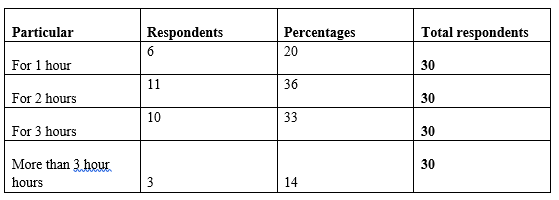
Table 2: Internet usage

Figure 3: Internet usage
In this research problem, analysis has been done on how long consumers are using the internet in 24 hours, which aids to recognize the weakness and strengths of China’s fashion market. This data analysis shows that 20% of consumers are using the internet for 1 hour. On another side, 36% of consumers are using the internet for their daily activities for 2 hours only. This rate of internet usage is a little bit low in case of consumers, who are using the internet for 3 hours. Approx. 33% of consumers are using internet services for 3 hours daily. On another side, there is also a range that exists, approx. 14% consumers are using internet services for more than three hours. Hence, from this discussion it is clear that the highest range of using internet services belong for 3 hours and the lowest range exists between more than three hours. At the end of this analysis, it is clear that consumers of China’s fashion industry are using the internet less or more, therefore there is a little chance of facing trouble while ordering any products online.
4. Please indicate, whether do you shop online in the scale from strongly disagree to strongly agree
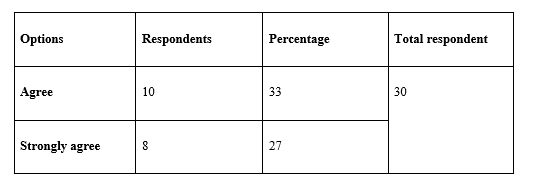

Table 4: Online Shopping

Figure 4: Online Shopping
In this research problem, the purchasing style of consumers has been checked. This analysis shows whether consumers in China’s fashion industry prefer to purchase products through online mode or from physical stores. In the view of Young et al. (2010), online shopping brings more valuable purchase experience to the consumer by considering all the available product at a time which allow the consumer to choose the best one for them. This result shows that almost 33% of consumers are gadget friendly. They are willing to purchase any products by using digital media or social media. They prefer to use the internet, company website, mobile applications and others online mode for managing their shopping. On another side, 7% of consumers prefer to visit and purchase their products from physical stores. Among those consumers, 27% of consumers strongly support this online shopping mode, as according to them, it saves their time and gives them the opportunity of selecting products from many options. However, 13% of those consumers are strongly opposed to this online mode. They prefer traditional purchasing style, where they can physically touch the product before buying. On another side, 20% of consumers are standing in a neutral zone. They are suitable with online purchasing mode along with offline mode both.
5. For how long have you been shopping online?
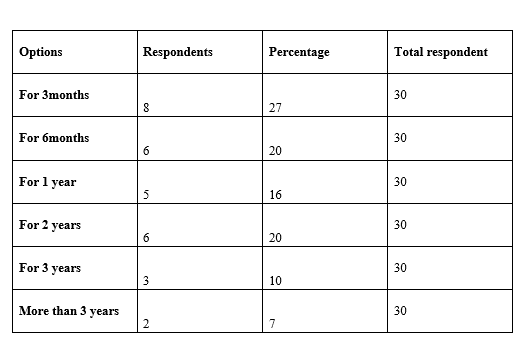
Table 5: Shopping time

Figure 5: Shopping time
According to Ye (2020), in recent times, the mentality of buying products through online mode has increased among consumers of China’s fashion market, especially for the people who are dealing with big brands like Zara, Uniqlo’s and others. This data set shows how this mentality of consumers shopping through online mode is going to change from period to period. As per this analytical result, almost 27% of consumers are doing their shopping through online for the last three months, whereas only 7% consumers are doing online shopping for more than three years. This rate has decreased for consumers who are shopping for just 1 year, this rate is 16%. On another side, almost 20% and 10% of consumers are dealing through online mediums since 2 years and 3 years, among which 10% is the minimum rate here. This ups and downs in online shopping rate indicates that the market for online sellers or buyers in China is still now fluctuating. Therefore this result is unable to meet the 3rd research objectives properly.
6. Which factors have influenced your buying through online sites?


Table 6: Factors have influenced buying

Figure 6: Factors have influenced buying
As per many research papers, it is clear shown that, there are many key factors, which influence the purchasing mentality of consumers in recent times. According to Kanten and Darma (2017), availability of the product variety and review are the most important factor that helps the consumer get the exact product. This research result would also aid to comprehend the ongoing situation of omni-care models in Chinese fashion sector and provide an expected output of this relevant analysis. In this analysis, such factors have tried to find out for understand the consumers demand of Zara and Uniqlo. Among 5 different factors, it has clearly shown that the cost of any products impacts the purchasing mentality of consumers maximum. Almost 33% of consumers are getting influenced by the products price, whereas the home delivery facility is not mandatory for all consumers. It only affects 17% of them. On the other hand, only 20% of consumers have a chance to check the ranges of several products within a specific time. This result also shows that 17% of consumers are expecting offers and discounts and only for 13% consumers going outside are not necessary. Therefore, studying this outcome, it is clear that Zara and Uniqlo both fashion companies need to deliver products at an effective price by meeting the 4th research objective.
7. Please indicate which of the following you shop most through e-commerce sites?
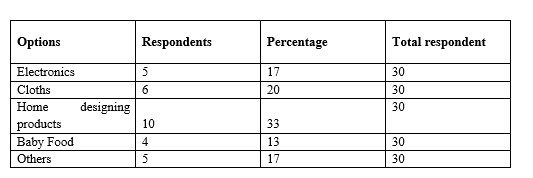
Table 7: E-commerce shopping

Figure 7: E-commerce shopping
In this section, products which are shopped most through online mode are identified here. Here, it is clearly shown that consumers are mainly ordering home appliances, almost 33% of consumers are ordering home designing items in China. After this home designing items are delivered, consumers in China prefer to deliver clothing items through online mode. Approx. 20% of consumers are involved in ordering clothes through e-commerce sites. On the other hand, almost 17% of consumers are purchasing electronic gadgets through several e-commerce sites. The Remaining 17% of consumers are getting involved in buying different categories of products. This scenario of buying several products through e-commerce sites has proved that the buying mentality of products has differentiated from consumers to consumers (Meera et al. 2017).
8. Please indicate, whether have you ever heard of the following brands?
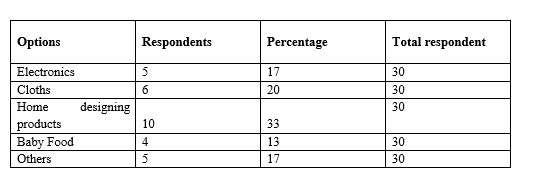
Table 8: Brand awareness

Figure 8: Brand awareness
In this question, it has shown how popular these Chinese fashion brands are to meet the 3rd reasearch objective. According to research results Uniqlo owns most popularity in comparison with other fashion brands. Almost 33% of consumers are aware about Uniqlo’s product, where H&M is known by only 13% of consumers in Chinese fashion market. After Uniqlo, New Look is reaching the 2nd position based on the product awareness. On the other side, Zara and Guchhi are getting the same rate, almost 17% of consumers are well known about these fashion brand’s products. Hence, it is clear that Uniqlo has a stronger market base than Zara. Thus this research result shows how Zara and Uniqlo gain several opportunities in China’s fashion market.
9. If you heard of Zara, can you please state for how long have you been buying clothes from this company?


Table 9: Customer Loyalty

Figure 9: Customer Loyalty
As per Iglesias et al., (2017), it is quite evident that the brand value always drives the consumer to buy the product from a particular brand and also good quality product increases the consumer loyalty. After checking the brand awareness of Zara among Chinese consumers, this analysis shows how many times consumers are purchasing products from this fashion organization. This outcome has shown that the highest rate for purchasing products through Zara’s online site is 6 months, this rate has gone up to 33%, whereas this rate has fallen for consumers purchasing for 3 months. This rate has reached up to 13%. On the other hand, consumers who are purchasing for 2 years have occurred the 2nd position in comparison with other time periods. Consumers purchasing for 1 year or above two years occur in the same position, almost 17% in the current market segment.
10. If you have heard about the brand Uniqlo, can you please state for how long have you been buying clothes from this company?


Table 10: Buying time period
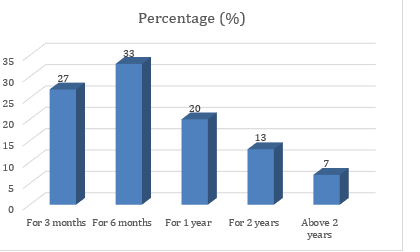
Figure 10: Buying time period
Once the market share of Zara has been checked, this study highlights towards the market awareness of uniqlo. Depending on previous assessment, it is clear that Uniqlo has a stronger consumer base than Zara in China’s fashion market. Here, the maximum rate of purchasing products through Uniqlo sites or stores is 33% since 6 months. This rate has tended to be minimum for consumers who are purchasing for more than 2 years, for them the rate is 7% only. Consumers who are purchasing for 3 months are little bit high, approximately 27%, whereas this rate is decreased for consumers purchasing for 1 year or 2 years. In that scenario, rates are 20% and 13% consequently.
11. How far do you agree that the design of Zara and Uniqlo are attractive in a scale of 1-5 (1=Strongly disagree, 5=Strongly agree)?

Table 11: Attractiveness
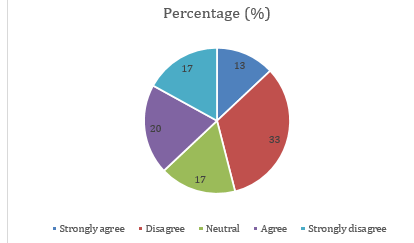
Figure 11: Attractiveness
According to Peavy, (2020), several factors including business strategies would create difference between organizations such as brand value, quality, price, product design, services and many more. This research result aids to decide about the attractiveness of Zara and Uniqlo’s fashion product among Chinese consumers. As per this analysis report, 33% of consumers’ do not find Uniqlo or Zara’s product much attractive, whereas 20% of consumers found it highly appreciated. On the other side, 17% of consumers are ok with those fashion companies’ products. They do not find it too attractive or less valuable. Approx 13% consumers are strongly opposing this attractiveness of these two leading fashion companies’ products, although 17% of consumers are highly satisfied with it.
12. How far do you agree that you get your ordered product on time when ordered from Zara and Uniqlo?


Table 12: Timely delivery
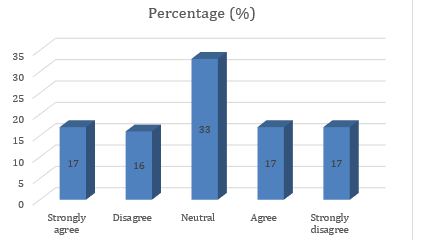
Figure 12: Timely delivery
According to researchers, maintaining good service quality like delivery within proper times aids to build good brand value. This analytical result shows that the rate of consumers agreeing and disagreeing with the timely delivery of Uniqlo’s product and Zara’s product are the same. Almost 17% of consumers with the timely delivery nature of these fashion companies, whereas another 17% consumers disagreed with this statement. On the other hand, 17% of consumers are strongly supporting this matter and the rest 16% are strongly opposing this time factor. Maximum 33% consumers are taking a moderate stand. This means that although some consumers are supporting Zara and Uniqlo’s on time delivery nature, these two organizations need to improve its service quality.
13. How far do you agree that the e-commerce platforms of these brands are easier for you to access and order clothes?


Table 13: E-commerce platform
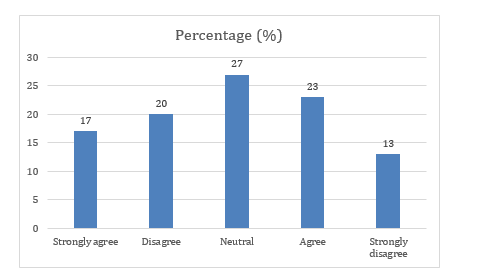
Figure 13: E-commerce platform
After completing a deeper apprehension of primary segments of Omni-care business concepts in Chinese fashion industry, this research result has tried to give an overview regarding the accessibilities of those brands online. As per this research result, 17% consumers are supporting this incorporation of e-commerce platforms in Chinese fashion brands, whereas 13% of consumers are till now opposing this facility. This result also shows that maximum portion of consumers are unable to take any specific decision, almost 27% of consumers are giving a neutral response on this e-commerce incorporation. On the other hand, 13% consumers are strongly opposing this new feature in China’s fashion market, and rest 17% is strongly supporting this new feature. This result shows how Zara and Uniqlo expand their business in fashion market.
14. How far are you satisfied with the products of these two companies?

Table 14: Customer satisfaction
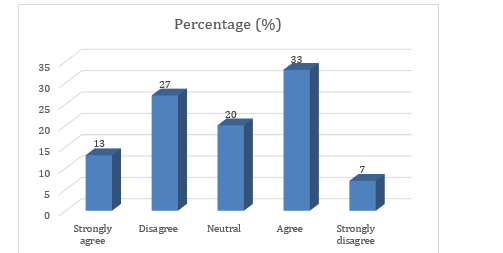
Figure 14: Customer satisfaction
In this section, this research result has tried to revolve around the purchasing behavior of consumers and their expectation from two leading Chinese fashion companies Zara and Uniqlo. This research outcome also aids to comprehend the failure rate and success rate of Zara and Uniqlo in China’s fashion segment by checking the satisfaction rate of consumers of these two organization’s products. This analysis shows that maximum range of consumers, almost 33% are satisfied of these brands products and among them 13% consumers are highly satisfied. On another side, 27% are not satisfied from these two brands and 7% of them are strongly disappointed. Thus this research result helps to know how consumer’s behavior affects Uniqlo and Zara’s business performance.
15. How far do you agree that you will recommend your family members and peers to buy from the e-commerce sites of these two brands?

Table 15: Recommendations
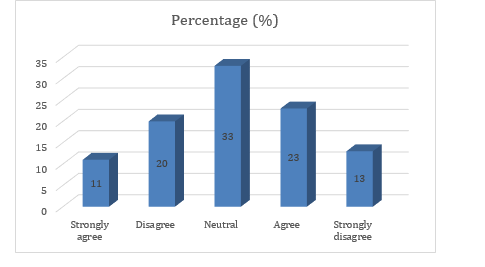
Figure 15: Recommendations
Based on this research result, different negative and positive footprints have arisen at research processing time, based on the consumer behavior towards such changes occurred in Chinese fashion industry. This result meets the research objective of based on the consumer’s behavior towards these two leading fashion brands of China. It shows that maxium of consumers are referring two brand names like Zara and Uniqlo, to their peers and family members, whereas only 20% are not referring those two brand names. These means that these two fashion brands need to put more effort to improve their business performance. Despite incorporating “Omni-care” model, they also try to understand their existing and future consumer’s mentality. Thus this research result helps to recognize the threats and opportunities of Uniqlo and Zara in China’s fashion market.
The primary intention of this research work is to identify the drivers of omni-channel and how it affects the activity of the fashion industry in China. This study aids to comprehend how several organizations redesign their business strategies during transformation of “omni-channel” retailing. Under this analysis, the author has tried to provide a validate conclusion based on the thorough investigation. As per this analysis result, it is clear that some consumers may not support this online mode, but the incorporation of “omni-channel” model means facebook, website like online modes are more acceptable in present time in China fashion market. However, as per this analysis result it is clear that the tendency of buying products through online mode is going to be high in Chinese fashion industry.
Chapter 5: Discussion
The researcher has collected primary data through the questionnaire method from the chosen 30 respondents. It has been found that among the respondents, 50% of respondents belong to the 24 to 29 age bar. Among the respondents, there were 33% of respondents whose age was between 18 to 23 and the remaining 17% of respondents were from 30 to 36 age bar. In the question about gender, it has been found that female respondents were 36 %, where male respondents were 50% which was maximum. The Remaining 14% of respondents belong to another gender category. However, researchers approached the respondents to know how much time they spend on the internet. In the response, 36% respondents which were maximum have depicted that they spend 2 hours on the internet. 33% of respondents depicted that they spend 3 hours and as per the 20% of respondents, they spend 1 hour on the internet. Along with that, it has been found that 14% of respondents spend more than 3 hours on the internet. In the research work of Krairit, (2018), the author stated that the number of active internet users is increasing continuously in the world as most of them prefer to spend their time on the internet.
Through the questionnaire, researchers wanted to find out whether the respondents prefer to shop from online mediums or not. It has been observed that most of the customers prefer to shop from online as 33% of respondents have agreed on this question. On the contrary, only 7% of respondents stated that they do not shop from online stores. Regarding this matter, Zarina and Gabriel, (2016) stated that a large number of customers prefer to purchase things from online rather than the offline medium.
The researcher asked the respondents how long they have been shopping online. In response, 20% of respondents stated that they are shopping from online stores for 6 months. Another 20% stated that they are shopping for 2 years. The maximum number of respondents which was 27% depicted that they are shopping for 3 months. Therefore, from the view of Singhal and Patra, (2018), it can be mentioned that online shopping is a popular medium among customers. As customers’ buying behaviour has changed in contemporary society, therefore, researchers asked the respondents to mention the factors that influence their buying behaviour in online mediums. 33% of customers responded that the pricing factor of the online store influenced them to make their buying decision. Along with that, Sheehan et al., (2019) provided the opinion that the low price, attractive discounts and offers influence the customers highly on their purchasing decision. 17% of respondents mentioned that because of the discounts and offers they choose online shops before offline stores. However, in the same question, 20% of respondents mentioned that they check different products online so that they prefer this channel to shop.
The researcher wanted to know from the customer about the preference of the type of products in e-commerce sites. Maximum respondents which were 33% have selected home designing products in this case. 20% of respondents have selected clothing options and 17% of respondents have selected electronics. These findings indicate that there are a huge variety of products in the online store and e-commerce site of the brands. In order to find out the impact of brand names, the researcher has asked the respondents to select from a list which brand name they hear. It has been noticed that customers are pretty aware of the brands. 33% of respondents have heard the name of ‘Uniqlo’ and 20% of respondents are aware of ‘New-look’. Respondents are also aware of Zara, Gucci and H&M which reflects that brand name impacts on the buying decision of the customers. In the view of Round and Roper, (2017), most of the customers choose their products on the basis of the brand names as they can be assured about the quality of the product.
In some questions of the questionnaire set, the researcher has mentioned brand names of the customers and asked for how long they are shopping from the particular brand. As in the question of Zara, 33% of respondents depicted that they are shopping from Zara for 6 months. 20% of respondents are shopping for 2 years from Zara. In the question of Uniqlo regarding the same matter, 33 % respondents depicted that they are shopping from the brand for 6 months and only 7% respondents stated that they are preferring to shop from Uniqlo for above 2 years. However, the researcher wanted to compare between Zara and Uniqlo about the design of the products as to whether they are attractive or not. According to 33% of respondents, the design of the approval of these two companies is pretty attractive which can be marked by 4 out of 5. According to Goworek et al., (2018), the creative and innovative design of the appeal is one of the ways for brands to attract new customers.
As home delivery of the product is one of the core business operations of Online business channels, therefore, The researchers have asked the respondents whether they get their product on time from the brands like Zara or Uniqlo or not. 33% of respondents have selected a neutral option in this question which means they could not state any view in this question. It has been observed that online stores are preferred by the customers because of the easy access and orders of the clothing item. That is why the researcher has asked how far they will agree with this statement. Most of the respondents who were 27% have taken neutral positions in this question as they were not sure about this statement. It is obvious that customers prefer online mediums as they easily order from their home and access the products also. Along with that in the view of Bhatti et al., (2018), there are many risk factors in the online orders of the products of the customers which restricts most of the customers to buy products from online. That is why in the question of the satisfaction level from the service of these two companies, Zara and Uniqlo, only 33% of respondents agreed with the question. In the last question, the researcher wanted to know from the respondents whether they would recommend the products of Zara and Uniqlo or not. According to 33% of respondents, they are not sure whether they are not sure about the fact that products of Zara or Uniqlo are suitable for recommendation or not. However, regarding this matter, Zhang et al., (2019), provided the opinion that in the online business medium, the recommendation has great importance.
Chapter 6- Recommendation and conclusion
6.1 Conclusion
Thus, it can be concluded that Omni-channel business model in Chinese fashion industry have been helpful for a number of retail organization to foster growth and development of their businesses. Similarly, the management of Zara and Uniqlo are also engaged in managing their business and continuity in customers’ interaction rate with the help of this business model adoption. In recent business industry in China, varying customers’ intentions have been appeared as one of the main issues to be stable in competitive market. In such situations, engagement of both online and offline marketing system that is Omni-channel marketing system becomes helpful for companies to maintain advancement in their business process sustainability.
Apart from this, it can be mentioned that application of Omni-channel marketing system in business process is the effective way to satisfy maximum numbers of targeted customers in a prominent manner. Thus, business organizations in retail sector in China are focused to support their growth with this type of business innovation. Moreover, it becomes also prominent that application of Omni-channel retailing system is also beneficial for targeted attainment of competitive advantages. Hence, no barriers affect the process of business management in market and stabilization of customer base is maintained in an efficient way
6.2 Linking with objectives[A7]
Objective 1: To thoroughly analyse the customer behaviour of the target market segments of these brands
This objective can be linked with2.2 and 2.6 of literature review. It has become helpful to identify that different external and internal factors bear close relationship with frequent changes of customers’ buying behaviour. The data analysis proves that the customers’ having healthy benefits in Omni-channel retailing become permanent customers of the concerned organisation.
Objective 2: To assess the anthropological features of the customers[A8]
This objective can be linked with 2.3 and 2.7 of the literature review part. It appears as one of the effective factors that until or unless basic requirements of customers have been met, business processes can never be successful in a prominent manner.
Objective 3: To assess the opportunities for Zara and Uniqlo to grow their business in the Chinese fashion industry
This can be linked with 2.8 of literature review part. It is an obvious fact that if a business company tries to attain critical market opportunities in concerned industry; it must focus on ongoing trends in industry. In this respect, Zara and Uniqlo become able to maintain business continuity as well as attaining competitive advantages in a genuine manner.
Objective 4: To identify the market strengths and weaknesses of the Chinese fashion market in order to analyse future opportunities
This objective can be critically linked with 2.9 of the literature review part. Based on this fact, it can be highlighted that Chinese retail companies such as Zara and Uniqlo need to identify market strengths and weaknesses for bringing changes in business process in a suitable way. As a result of this, they become able to experience huge advantages based on application of Omni-channel business model in service process.
6.3 Recommendation
Recommendation 1: Development of resource management techniques in business for overcoming resources based barriers
Zara and Uniqlo authorities can focus greatly on development of the resource management process. It can be measured by analyzing the amount of net operating income and rate of annual expenditure. It will help them to save resources and engage them for prominent business development in future. Implementation of Omni-channel business model will be managed efficiently through the use of monetary resources in a prominent manner.
Recommendation 2: Enhancement of business partnership with national and international companies for having effective business ideas
The management of retail sectors of Zara and Uniqlo can develop business partnership with different national and international organizations which may be helpful for them to attain excellence in managing growth and development of business process through Omni-channel retailing. In order to enhance business partnership, internal[A9] business efficiency and current market scenario need to be considered by organizational authorities of these organizations.
Recommendation 3: Management of workforce in a proper manner[A10] to serve potential customers with the help of digital tools
Enhancement of workforce stability is one of the essential criteria to maintain continuity in business development process. Thus, it can be mentioned that providing proper training to employees will be beneficial for the management of Zara and Uniqlo to support better customer service through Omni-channel retailing. Besides, development of internal business process can also be managed in an effective way.
6.4 Future Scopes
It is an evident fact that almost all of the research studies try to grab a foothold in future aspects and this research study is not an exception. The research study can be beneficial for future researchers to proceed with in-depth research based on application of Omni-channel marketing and its impacts on business industries other than retail sector. Besides, this research also encounters contrasting views for adopting Omni-channel business model by two different Chinese organizations such as Zara and Uniqlo. In this regard, this discussion will be helpful for promising researchers to consider unique aspects of fashion industry in China in future. Apart from this, collection of statistical data in this research through survey can be advantageous for highlighting the loopholes of B2B practices in future.
6.5 Limitations
This study has faced different types of constraints to be completed in an effective way within fixed schedule of time. Unavailability of monetary fund became problematic to assess research base and maintain all activities in a sequential manner. Besides, in terms of collecting data about retail business markets in China, researchers have faced setbacks to consider different types of online reports and current publications. Automatically, they became unable to complete all research activities within fixed time. In order to collect primary data by means of survey process, researchers have faced issues as all the time all of the targeted individuals in sample may not be available. Along with this, confusing answers by participants during survey have become also a prominent limitation of this research.
References
Agolla, J.E., Makara, T. and Monametsi, G., 2018. Impact of banking innovations on customer attraction, satisfaction and retention: the case of commercial banks in Botswana. International Journal of Electronic Banking, 1(2), pp.150-170.
Alalwan, A.A., 2018. Investigating the impact of social media advertising features on customer purchase intention. International Journal of Information Management, 42, pp.65-77.
Barrie, L., 2020. China Clothing Factories Struggling To Get Back On Track. [online] Just-style.com. Available at: <https://www.just-style.com/analysis/china-clothing-factories-struggling-to-get-back-on-track_id138148.aspx> [Accessed 14 May 2020]
Bhatti, A., Saad, S. and Gbadebo, S.M., 2018. Convenience Risk, Product Risk, and Perceived Risk Influence on Online Shopping: Moderating Effect of Attitude. Science Arena Publications International journal of Business Management, 3(2), pp.1-11.
Bonetti, F., Perry, P. and Fernie, J., 2017. The evolution of luxury fashion retailing in China. In Luxury fashion retail management (pp. 49-67). Springer, Singapore.
Cai, Y.J. and Lo, C.K., 2020. Omni-channel management in the sharing economy era: A systematic review and future research agenda. International Journal of Production Economics, p.107729.
Cook, S.C. and Yurchisin, J., 2017. Fast fashion environments: consumer’s heaven or retailer’s nightmare?. International Journal of Retail & Distribution Management.
Davis, B., 2020. What You Need To Know About China’s ‘New Retail’ – Inside Retail. [online] Inside Retail. Available at: <https://insideretail.com.au/news/what-you-need-to-know-about-chinas-new-retail-201907> [Accessed 6 February 2019].
Eggers, F., Hatak, I., Kraus, S. and Niemand, T., 2017. Technologies that support marketing and market development in SMEs—Evidence from social networks. Journal of Small Business Management, 55(2), pp.270-302.
Etikan, I., Musa, S. A., &Alkassim, R. S. (2016). Comparison of convenience sampling and purposive sampling. American journal of theoretical and applied statistics, 5(1), 1-4.
Goworek, H., Oxborrow, L., McLaren, A., Claxton, S., Cooper, T. and Hill, H., 2018. Creativity at Work and Sustainable Product Development: Practitioner Perspectives from the Clothing Industry. In The Palgrave Handbook of Creativity at Work (pp. 563-582). Palgrave Macmillan, Cham.
Grayson, D. and Hodges, A., 2017. Corporate social opportunity!: Seven steps to make corporate social responsibility work for your business. Routledge.
Iglesias, O., Ind, N. and Alfaro, M., 2017. The organic view of the brand: A brand value co-creation model. In Advances in corporate branding (pp. 148-174). Palgrave Macmillan, London.
Jaradat, R., Adams, F., Abutabenjeh, S. and Keating, C., 2017. The complementary perspective of system of systems in collaboration, integration, and logistics: a value-chain based paradigm of supply chain management. Systems, 5(4), pp.50-60.
Kalla, R., Murikinjeri, S., Abbaiah, R. and Samanthapudi, V.R., 2017. Price elasticity model for fashion products. Global Journal of Pure and Applied Mathematics, 13(7), pp.3727-3737.
Kanten, I.K. and Darma, G.S., 2017. Consumer Behaviour, Marketing Strategy, Customer Satisfaction, and Business Performance. Jurnal Manajemen Bisnis, 14(2), pp.143-165.
Khan, B.A. and Naeem, H., 2018. The impact of strategic quality orientation on innovation capabilities and sustainable business growth. International Journal of Quality & Reliability Management.
Koc, T. and Bozdag, E., 2017. Measuring the degree of novelty of innovation based on Porter’s value chain approach. European Journal of Operational Research, 257(2), pp.559-567.
Krairit, D., 2018. The new face of internet user typology: The case of Thailand. Journal of theoretical and applied electronic commerce research, 13(2), pp.58-79.
Kubickova, M., 2019. The impact of government policies on destination competitiveness in developing economies. Current Issues in Tourism, 22(6), pp.619-642.
Kumar, V., Rajan, B., Gupta, S. and Dalla Pozza, I., 2019. Customer engagement in service. Journal of the Academy of Marketing Science, 47(1), pp.138-160.
Marketing China, 2020. E-Commerce In China : Top Agency. [online] Marketing China. Available at: <https://www.marketingtochina.com/why-choose-us-to-develop-your-e-commerce-strategy-in-china/> [Accessed 14 May 2020]
Meera, M.R., Padmaja, R. and Siddique, R.M.A., 2017. Preference of Customers towards Online Shopping Applications
Mertens, W., Pugliese, A., & Recker, J. (2017). Quantitative data analysis. A companion.
Nagy, J., Oláh, J., Erdei, E., Máté, D. and Popp, J., 2018. The role and impact of industry 4.0 and the internet of things on the business strategy of the value chain—The case of Hungary. Sustainability, 10(10), p.3491-3512.
Nelson, C., 2014. Understanding Chinese Consumers – China Business Review. [online] China Business Review. Available at: <https://www.chinabusinessreview.com/understanding-chinese-consumers/> [Accessed 3 June 2020]
Nisar, T.M. and Prabhakar, G., 2017. What factors determine e-satisfaction and consumer spending in e-commerce retailing?. Journal of Retailing and Consumer Services, 39, pp.135-144.
Noto La Diega, G., 2019. Can the law fix the problems of fashion? An empirical study on social norms and power imbalance in the fashion industry. Journal of Intellectual Property Law & Practice, 14(1), pp.18-24.
Oliver Wyman, 2020. China Blends Online And Offline Retail Worlds. [online] Oliverwyman.com. Available at: <https://www.oliverwyman.com/our-expertise/insights/2018/feb/retail-consumer-journal-vol-6/china-blends-online-and-offline-retail-worlds.html> [Accessed 3 June 2020]
Pawłowski, M. and Pastuszak, Z., 2017. B2B customers buying behavior. International Journal of Synergy and Research, 5, pp.19-25.
Peavy, K., 2020. China Retail’s Newest Inflection Point: From E-Commerce To Omni-Channel | China Research Center. [online] China Research Center. Available at: <https://www.chinacenter.net/2018/china_currents/17-1/china-retails-newest-inflection-point-e-commerce-omni-channel/> [Accessed 3 June 2020].
Quinlan, C., Babin, B., Carr, J., & Griffin, M. (2019). Business research methods. South Western Cengage.
Rahi, S. (2017). Research design and methods: A systematic review of research paradigms, sampling issues and instruments development. International Journal of Economics & Management Sciences, 6(2), 1-5.
Rahman, M.A., Islam, M.A., Esha, B.H., Sultana, N. and Chakravorty, S., 2018. Consumer buying behavior towards online shopping: An empirical study on Dhaka city, Bangladesh. Cogent Business & Management, 5(1), p.1514940.
Round, G. and Roper, S., 2017. When and why does the name of the brand still matter?. European journal of marketing.
Ryan, G. (2018). Introduction to positivism, interpretivism and critical theory. Nurse researcher, 25(4), 41-49.
Saebi, T., Lien, L. and Foss, N.J., 2017. What drives business model adaptation? The impact of opportunities, threats and strategic orientation. Long range planning, 50(5), pp.567-581.
Sheehan, D., Hardesty, D.M., Ziegler, A.H. and Chen, H.A., 2019. Consumer reactions to price discounts across online shopping experiences. Journal of Retailing and Consumer Services, 51, pp.129-138.
Simon, F. and Tossan, V., 2018. Does brand-consumer social sharing matter? A relational framework of customer engagement to brand-hosted social media. Journal of Business Research, 85, pp.175-184.
Simpson, J., 2019. How To Keep Pace With Chinese Consumer Behaviour | Wordbank. [online] Wordbank (UK). Available at: <https://www.wordbank.com/uk/blog/chinese-consumer-behaviour/> [Accessed 3 June 2020]
Singhal, P. and Patra, S., 2018. A Study on Consumer Behaviour towards Online Shopping In Kolkata. In International Business Research Conference, IOSR Journal of Business and Management (pp. 91-102).
Sobol, K., Cleveland, M. and Laroche, M., 2018. Globalization, national identity, biculturalism and consumer behavior: A longitudinal study of Dutch consumers. Journal of Business Research, 82, pp.340-353.
Statista, 2020. China: Internet Penetration Rate | Statista. [online] Statista. Available at: <https://www.statista.com/statistics/236963/penetration-rate-of-internet-users-in-china/> [Accessed 14 May 2020]
Syaekhoni, M.A., Alfian, G. and Kwon, Y.S., 2017. Customer purchasing behavior analysis as alternatives for supporting in-store green marketing decision-making. Sustainability, 9(11), pp.2008-2220.
Taherdoost, H., 2018. A review of technology acceptance and adoption models and theories. Procedia manufacturing, 22, pp.960-967.
Tajvidi, M., Wang, Y., Hajli, N. and Love, P.E., 2017. Brand value Co-creation in social commerce: The role of interactivity, social support, and relationship quality. Computers in Human Behavior, p.105-120.
Tjora, A. (2018). Qualitative research as stepwise-deductive induction. Routledge.
Tradingeconomics, 2020. China GDP Annual Growth Rate | 1989-2020 Data | 2021-2022 Forecast | Calendar. [online] Tradingeconomics.com. Available at: <https://tradingeconomics.com/china/gdp-growth-annual> [Accessed 3 June 2020]
Uniqlo, 2020. Women’s, Men’s & Children’s Clothing | Lifewear | UNIQLO UK. [online] Uniqlo.com. Available at: <http://www.uniqlo.com/> [Accessed 19 May 2020].
Wiener, M., Hoßbach, N. and Saunders, C., 2018. Omnichannel businesses in the publishing and retailing industries: Synergies and tensions between coexisting online and offline business models. Decision Support Systems, 109, pp.15-26.
Williams, D., 2020. E-Commerce In China: A Present And Future Market Overview. [online] Verdict Retail. Available at: <https://www.retail-insight-network.com/features/e-commerce-in-china/> [Accessed 14 May 2020]
Xu, G., Wu, Y., Minshall, T. and Zhou, Y., 2018. Exploring innovation ecosystems across science, technology, and business: A case of 3D printing in China. Technological Forecasting and Social Change, 136, pp.208-221.
Xu, Y., Chi, T. and Su, J. eds., 2018. Chinese Consumers and the Fashion Market. Singapore: Springer.
Yarahmadi, H. and Hasheminejad, S.M.H., 2020. Design pattern detection approaches: a systematic review of the literature. Artificial Intelligence Review, pp.1-58.
Ye, Y., Lau, K. and Teo, L., 2020. Drivers And Barriers Of Omni-Channel Retailing In China: A Case Study Of The Fashion And Apparel Industry. [online] Researchbank.rmit.edu.au. Available at: <http://researchbank.rmit.edu.au/view/rmit:49316> [Accessed 3 June 2020].
Young, W., Hwang, K., McDonald, S. and Oates, C.J., 2010. Sustainable consumption: green consumer behaviour when purchasing products. Sustainable development, 18(1), pp.20-31.
Yrjölä, M., Spence, M.T. and Saarijärvi, H., 2018. Omni-channel retailing: propositions, examples and solutions. The International Review of Retail, Distribution and Consumer Research, 28(3), pp.259-276.
Zara, 2020. ZARA MAINLAND CHINA / 中国大陆 | New Collection Online. [online] Zara.cn. Available at: <https://www.zara.cn/cn/en/> [Accessed 14 May 2020]
Zara, 2020. ZARA Official Website. [online] Available at: <https://www.zara.com> [Accessed 3 June 2020].
Zarina, N.Z. and Gabriel, S.J., 2016. Factors influencing customers preference and satisfaction in online shopping-a study with reference to Chennai city. ACADEMICIA: An International Multidisciplinary Research Journal, 6(10), pp.7-18.
Zhang, H., Wang, Z., Chen, S. and Guo, C., 2019. Product recommendation in online social networking communities: An empirical study of antecedents and a mediator. Information & Management, 56(2), pp.185-195.
Zhang, X., Gale, C. and Eckert, C., 2018. Chinese Consumers and the Knitwear Fashion Market. In Chinese Consumers and the Fashion Market (pp. 193-212). Springer, Singapore.




